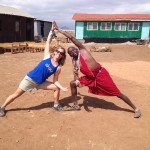A Day in Nairobi’s Kibera Slums: Seeing Immense Poverty Up Close

I felt speechless after walking through the Kibera slums in Nairobi, Kenya, guided by Joshua my extremely knowledgeable tour guide and co-founder of the Kibera Community Empowerment Organisation (KCEO). At one point I literally had to put on sunglasses to cover up tears that can only be explained by the emotionally overwhelming experience that is a slum tour.
I’m still not certain I can find the words to describe the level of extreme poverty in this monumentally dense urban slum. Nor do I know if I can paint an accurate picture of what 1 million people on 2.5 square kilometers looks like in the middle of a city of 4 million. But I will certainly try.
As I solemnly stumbled down the hill half staring at the ground in my imitation Tom’s trying to avoid stepping in sewage or mud, not that I could differentiate the two, I tried not to make eye contact with anyone for too long. At first no one seemed to notice us despite the blatant contrast between the color of my skin, the quality of my clothes, and the touristy konga fabric shoulder bag I gripped cautiously in front of me. Then the “mzungus” started as we walked past the police station composed of two shipping containers stacked one on top of the other with official letters painted on the side: police post.
I smiled awkwardly but quickly stopped because I thought that might be wrong. But what is the appropriate way to approach strangers in a place where you both know the truth, and you are on opposite sides of it? As we wandered deeper into the heart of it all, I began to smile and waive at children in response to their small eager voices shouting “hi, how are you?” in innocent unison. Some giggled bashfully, some stuck their hands out to make contact, and others ran away. But their faces lingered in my mind as I walked through their streets and trespassed on the land that neither of us held claim too.
What is the appropriate way to approach strangers in a place where you both know the truth, and you are on opposite sides of it?
As we came to a bridge that offers a dry path over the narrow river that dissects the slums, I avoided eye contact with a frail, dying woman being carried by two others with a look of seriousness in their eyes. I didn’t want her to know I could feel her pain radiating off her like a thick presence in the air, because her struggle was beyond my expertise. She was probably too far gone to notice my intrusion, but I felt uncomfortable bearing witness to her suffering nonetheless.
Past her, was a group of small children laughing on the bridge all dressed in tattered clothing. A girl with a magnetic smile told me her name was Nisi, and I murmured that it was pretty even though I wanted to say so much more. I wanted to know her story, and tell her that she mattered and that I’m sorry that she was born there and that I was born into a house with multiple rooms, flush toilets and beds. I tried to tell her with my eyes, but she smiled sheepishly and continued playing with her friends oblivious to my concern.
A Day in Nairobi’s Kibera Slums: Seeing Immense Poverty Up Close
A group of young adults in matching neon green t-shirts that read: “I participated in cleaning up Kibera,” were clumped together jabbing sticks in the murky river trying to retrieve garbage that appeared to permanently pollute the water. On the other side of the bridge, children circled around a small water hole immersing their hands in and splashing one another as they laughed and screamed with delight at the entertainment they’d found in a dirty puddle. I didn’t know if I felt sad because they had no store bought toys or regard for hygiene and health, or happy because they were unaware and full of smiles regardless.
As we continued through the narrow corridors up and down steep and unstable ground, I couldn’t help but notice the various pipes and wires bulging across the path threatening to trip anyone not careful enough to mind their step. On the right, I caught a glimpse of two sleeping piglets and on the left, a couple of children carrying puppies by the scruff on their necks. Gravity forced the sewage down the center of the path in a steady stream as I tried to dodge its persistent flow, while children and elders scurried past me with no regard for their footing.
I wanted to know her story, and tell her that she mattered and that I’m sorry that she was born there and that I was born into a house with multiple rooms, flush toilets and beds.
Eventually we reached the Human Needs Project town center: a place of hope, opportunity and action. With the mission statement: provision of integrated quality services for holistic sustainable solutions to the challenges of living in slums. The modern multiple level structure offered a cafe with nutritional snacks, laundry, internet and computers, showers and toilets for a small fee of 5KSH (10 cents).
The walls inside the impressively clean and lined with remarkable acrylic paintings done by children in the slums to fund their education. I felt drawn to the skilled brush strokes of Joseph’s zebra piece with strong white and black stripes surrounded by a flurry of color. I decided I couldn’t leave without it and despite the cringe I felt handing over $70, I could not walk away from a cause so genuine and fundamental to change.
I left the center inspired but slightly conflicted by the anomaly of how such a structure is truly benefiting the community when many of the slum residents can’t afford the services. We followed the train tracks littered with trash and people. Along the sides, you could buy any number of random items from the many stores displayed in front of metal shacks. We passed a tarp laid out with various types of used locks with a worn old man sitting patiently behind it. A little further ahead a small girl sat alone, next to a basket full of unidentified food. We smiled at each other, but my legs kept moving forward, careful not to linger too long and get her hopes up.
A Day in Nairobi’s Kibera Slums: Seeing Immense Poverty Up Close
As we were strategically guided through the mounds of garbage, streams of sewage and sick peoplee, I pondered what it is like to live in Kibera. Sleeping under scraps of metal and plastic tied desperately together for shelter, or even in one of the more natural mud huts bound together by rotten wooden beams on a hill. Sharing a tight 10 by 10ft space with ten people and no bed, and with nothing but the closeness of fellow bodies on the dirt floor for warmth.
As I pondered this reality for the million slum dwellers, the structures started to shift abruptly into bigger houses made of more stable materials. We passed what can only be assumed as the homes of slum lords (or the politically correct title, “Area Chiefs”), rigged with electricity and other prized possessions. Even the products improved and became more expensive in the shops closer to the outskirts of the slums. An unaccompanied stand of TVs, printers, and microwaves sat in front of a school converted into a church made of refurbished metal scraps with USAID’s emblem painted across the side.
If two young boys from the slums could start something so impressive, what is to stop any of those smiling faces from changing their own future?
My thoughts didn’t wander for too long before we arrived at the KCEO office, where we met some of the other staff. The office itself was a small room less than 10 feet wide or long, with three desks containing a handful of outdated computers. Our guide, Joseph showed me a binder with the subject matter they cover in their youth behavioral change programs ranging from sex education to anti-corruption.
He explained how he used the plastic they collected around the slums to make building materials and that the profits are invested right back into the community through their youth education programs.
As he spoke passionately about being the only sustainable motivator, I became more inspired, hanging onto his every word. His genuine desire to change his community had turned into something real. He managed to create tangible opportunities for his friends, family and neighbors out of the trash around him. KCEO’s recycling programs have funded hundreds of kids’ school fees, with minimal operational costs. I was hooked.
I left the office a little more optimistic than I had entered, and the feeling began to grow as I walked past the same smiling kids whose futures suddenly seemed a little more hopeful. If two young boys from the slums could start something so impressive, what is to stop any of those smiling faces from changing their own future?
The injustice is still very much alive and its presence is still heavy across the developing world, but the solutions are springing up exactly where they should be–from within. I’m not sure what my day in the slums will mean for me long-term, but for now, I feel inspired. I peeked into the reality of urban poverty, but I found something unexpected. For the first time in a long while, I felt hope.
A Day in Nairobi’s Kibera Slums: Seeing Immense Poverty Up Close
Related Reading
Kenya Travel: 6 Misconceptions I had before I Went
Tips for Women Travelers in Kenya
Following Strangers in Kenya
A Kenya Safari Fit for a Toddler
On the Fried Deliciousness that is Kenyan Food
Living in Kenya and Feeling the Distance from Home
Have you traveled to Kenya? Email us at editor@pinkpangea.com to share your experience and advice with the Pink Pangea community. We can’t wait to hear from you.
A Day in Nairobi’s Kibera Slums: Seeing Immense Poverty Up Close top photo credit: Ben Sales








